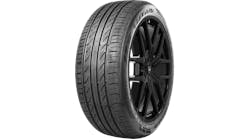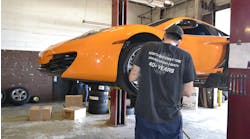The combination of Pirelli’s P Zero Silver hard and P Zero Yellow soft tyre is being used for the final time this year, at the Indian Grand Prix: one of the fastest and most spectacular circuits on the Formula One calendar, where nine of the 10 corners between turns five and 14 are taken between 200 and 250kph.
Red Bull’s Sebastian Vettel continued his recent run of form to set the fastest time of free practice: 1m26.221s using the soft compound tyres in FP2, a tenth of a second ahead of his team mate Mark Webber. Vettel was also dominant in India last year, winning the race from pole and setting fastest lap.
Pirelli’s compounds are all generally softer than last year’s equivalents. So as usual the teams devoted the two Friday free practice sessions to accumulating as much data as possible about tyre performance with a wide range of fuel loads and set-ups, in order to help formulate the best race strategies.
All the drivers used the hard tyres in the morning – where Vettel was again quickest by three-tenths of a second – before moving onto the soft tyre in the second half of FP2 in the afternoon, run with 38 degrees of track temperature. Caterham driver Vitaly Petrov and Toro Rosso’s Daniel Ricciardo were the first drivers to switch to the soft tyres with 50 minutes to go. Subsequently, all the drivers ran on soft tyres to complete long runs on heavy fuel, simulating the most likely scenario for the frontrunners at the beginning of the race. Force India’s Paul di Resta ended FP2 on the hard tyres at his team’s home race, as did Mercedes driver Michael Schumacher and Toro Rosso’s Jean-Eric Vergne.
The difference between the soft tyres and the hard tyres in India is expected to be in the region of 0.8 to one second per lap but the situation is made more complicated by the high degree of track evolution that exists at the Buddh circuit as the surface rubbers in. During FP1 for example, some drivers were improving their times by up to a second per lap as the session went on, while Vettel set the fastest time (1m27.619s) in the final five minutes on the hard tyre.
Pirelli’s motorsport director Paul Hembery commented: “With quite a significant performance gap between the two compounds and a track that is still rapidly evolving, teams have the opportunity to use these speed differentials as a basis of their race strategies, which are sure to play an important part in the weekend. As always, to get the best out of the tyres the drivers will need to prioritize keeping them within their ideal operating temperature here. Last year the winning strategy consisted of two stops, but this year one pit stop might even be possible for some drivers from what we can see so far. Both Red Bull drivers have set a very rapid pace so far, but it’s the combination of speed and strategy that will win the race on Sunday and at this point we never know exactly how much fuel the teams are running. With the tyres coping with the demands of India very well, we would expect the race pace of the top drivers to be closely matched.”


